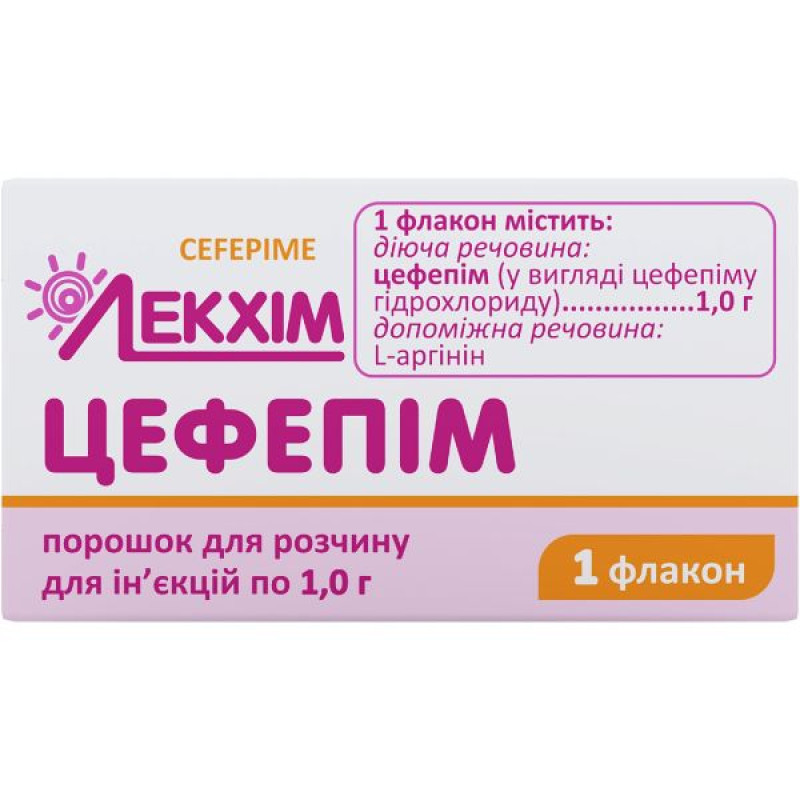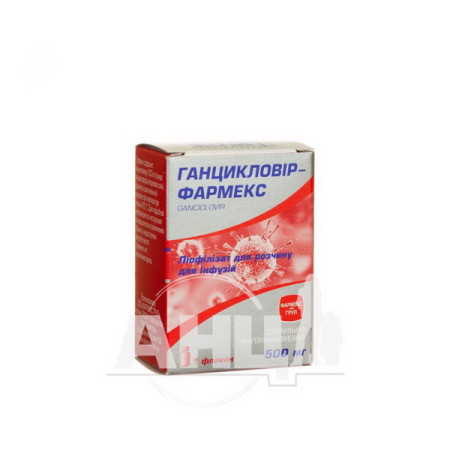Cefepime powder for solution for injection 1 g vial No. 1

Cefepime powder for solution for injection is indicated for infections whose pathogens are sensitive to cefepime.
adults: septicemia; intra-abdominal infections, including peritonitis and biliary tract infections; skin and subcutaneous tissue infections; gynecological infections; respiratory tract infections, including pneumonia, bronchitis; prevention of postoperative complications in intra-abdominal surgery; empirical therapy of patients with neutropenic fever. children: pneumonia; urinary tract infections, including pyelonephritis; skin and subcutaneous tissue infections; septicemia; empirical therapy of patients with neutropenic fever; bacterial meningitis.Composition
Active ingredient: cefepime;
1 vial contains cefepime (as cefepime hydrochloride) 1.0 g;
Excipients: L-arginine.
Contraindication
Hypersensitivity to cephalosporin antibiotics or L-arginine, penicillins or other β-lactam antibiotics.
Method of application
Before using the drug, a skin test should be performed for tolerance.
The usual adult dosage is 1 g, administered intravenously or intramuscularly at 12-hour intervals. The usual duration of treatment is 7-10 days; longer treatment is possible in severe infections.
Application features
Pregnant women
Cefepime should be administered to pregnant women only if the expected benefit to the mother outweighs the potential risk to the fetus.
Children
The drug is used in children from 1 month of age.
Drivers
The effect on the ability to drive and use machines has not been studied, however, when using the drug, the possibility of adverse reactions from the nervous system should be taken into account.
Overdose
Symptoms. In cases of significant excess of recommended doses, especially in patients with impaired renal function, the manifestations of side effects are enhanced. Symptoms of overdose include encephalopathy, accompanied by hallucinations, impaired consciousness, stupor, coma, myoclonus, epileptiform seizures, neuromuscular excitability.
Treatment. It is necessary to stop the administration of the drug, conduct symptomatic therapy. The use of hemodialysis accelerates the removal of cefepime from the body; peritoneal dialysis is ineffective. Severe allergic reactions of the immediate type require the use of adrenaline and other forms of intensive therapy.
Side effects
Cefepime is generally well tolerated.
Allergic reactions: rash, itching, urticaria, erythema, anaphylactic shock, fever. Gastrointestinal: diarrhea, nausea, vomiting, constipation, abdominal pain, dyspepsia, stomatitis, colitis (including pseudomembranous). Cardiovascular: chest pain, tachycardia. Hematopoietic: agranulocytosis, hypereosinophilia, neutropenia, thrombocytopenia, prolongation of prothrombin time and activated partial thromboplastin time, hypotension, vasodilation, decreased serum phosphate concentration. Respiratory: cough, sore throat, shortness of breath. Central nervous system: headache, dizziness, insomnia, paresthesia, anxiety, confusion, convulsions; encephalopathy, which may manifest as loss of consciousness, hallucinations, stupor, coma; myoclonus. Infections: candidiasis. Reactions at the injection site: with intravenous infusion - phlebitis and inflammation, with intramuscular injection - pain, inflammation. Other: asthenia, increased sweating, vaginitis, peripheral edema, back pain.Interaction
There are possible cases of increased activity of oral anticoagulants in patients receiving cephalosporins.
When high doses of aminoglycosides are used concomitantly with cefepime, renal function should be closely monitored because of the potential nephrotoxicity and ototoxicity of aminoglycoside antibiotics. Nephrotoxicity has been reported following concomitant use of other cephalosporins with diuretics such as furosemide.
Cefepime is compatible with the following solvents: water for injection, 0.9% sodium chloride solution for injection (with or without 5% glucose solution), 5 and 10% glucose solutions for injection, 1/6M sodium lactate solution for injection, lactated Ringer's solution (with or without 5% glucose solution), lidocaine hydrochloride solution.
Storage conditions
Store out of the reach of children in the original packaging at a temperature not exceeding 25 °C.
Shelf life - 2 years.
There are no reviews for this product.
There are no reviews for this product, be the first to leave your review.
No questions about this product, be the first and ask your question.

